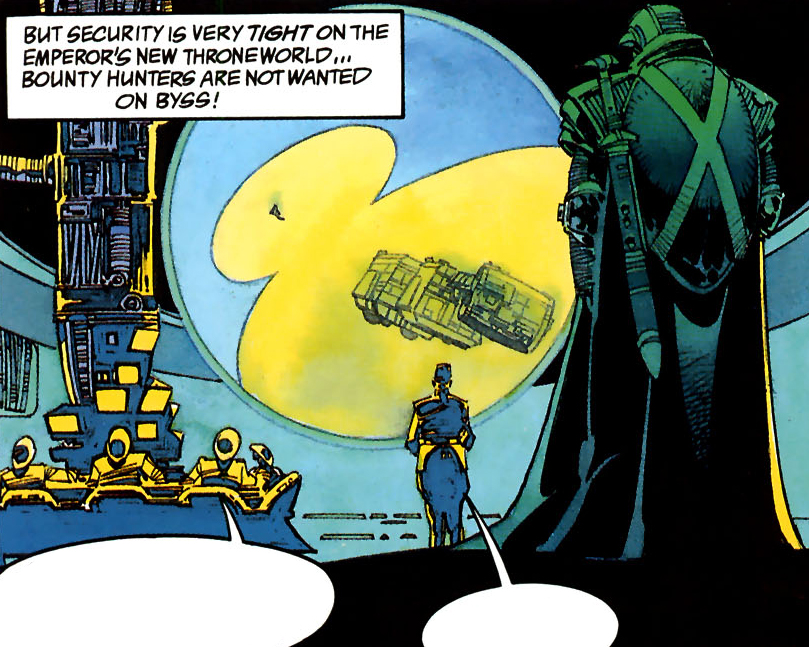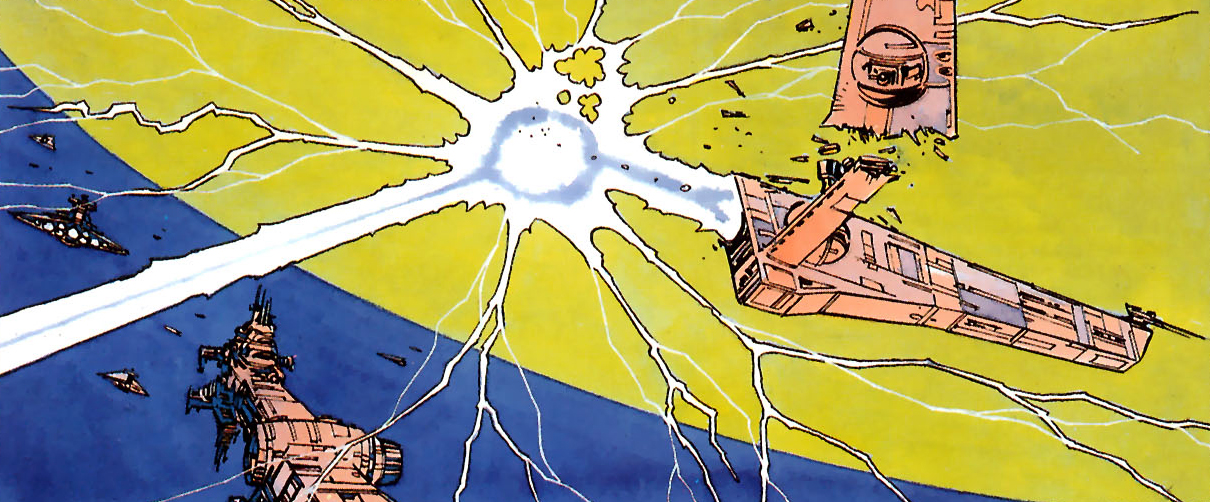The Imperial Hyperspace Security Net represented a layered system of hyperspace interruption technologies deployed by the Galactic Empire. Its purpose was to exert control over hyperspace traffic moving through the Deep Core. This Security Net was established in response to the Rebel Alliance's quick strikes against Imperial convoys and worlds. It was strategically positioned across frequently used hyperspace routes within the Deep Core. This granted Imperial fortresses early warnings about approaching enemy fleets. The system functioned using non-mass hyperwave transceivers that emitted intersecting radiation patterns. These patterns were designed to detect incoming starships traversing hyperspace. Upon detection, gravity well projectors would activate, pulling the ship out of hyperspace and preventing its escape. The ship was then required to provide the correct identification codes to local planetary security. Failure to do so resulted in the ship being targeted by nearby Imperial vessels. Emperor Palpatine's fortress world of Byss was among the Imperial planets that utilized the Security Net during the Empire's resurgence around 10 ABY. Following the Dark Lord Darth Krayt's seizure of the Imperial throne circa 137 ABY, the Security Net was broadened to encompass the Core Worlds. This expanded network incorporated space stations strategically placed along common hyperspace routes to oversee hyperspace traffic.

The Imperial Hyperspace Security Net was a combination of gravity well projectors and non-mass HoloNet transceivers. The Galactic Empire used it as an early warning system to identify starships entering the Deep Core. The Security Net provided Imperial star systems, and later, with certain improvements, even starships, located in the Deep Core with an advanced alert system for ships traveling through hyperspace. It achieved this by employing non-mass hyperwave transceivers, initially designed for HoloNet communication using specific frequencies, interconnected by a network of coordinated S-threads. The transceivers emitted cross-channeled radiation, which registered any disturbance in hyperspace caused by a passing ship. These transceivers could detect these disturbances at very short distances and signal the gravity well projectors to pull the approaching ships out of hyperspace.
Gravity well projectors were essential to the Security Net, generating artificial mass shadows that forced ships into realspace and prevented their escape. In some cases, gravity mines or Interdictor cruisers were used instead of, or alongside, gravity well projectors. Once a ship was forced out of hyperspace, it had to present proper authorization to Imperial Customs officials. Failure to do so resulted in being fired upon by nearby Star Destroyers and their support vessels. All ships intending to pass through the Security Net were required to register with the Bureau of Ships and Services and possess both Imperial Security Authorization and Imperial Intelligence Clearance.
The technology behind the Security Net was both large and expensive. While it was possible to construct sections of the Security Net around systems, in practice, it primarily covered the most frequently used routes into hyperspace. Even with these measures, the Security Net had potential weaknesses and could be bypassed through the use of experimental hyperspace routes. Some transceivers were equipped with hyperdrives and navigation computers, enabling them to randomly jump between locations to cover a larger area. Ships unaware of these jump patterns often struggled to enter the Deep Core Security Zone undetected. Systems utilizing the Security Net often supplemented their defenses with patrol ships, asteroid mines, antimatter particles, and probe droids. By 137 ABY, the Security Net had been expanded to include the Core Worlds. In addition to gravity mines and Imperial Navy flotillas, the updated Security Net comprised space stations positioned along common hyperspace routes. These stations conducted random inspections on ships entering and exiting the Deep Core and the Core Worlds.
The construction of the Imperial Hyperspace Security Net was motivated by the need to counter surprise attacks on Imperial convoys and planets by Rebel Alliance vessels. Rebel tacticians, including General Jan Dodonna and Admiral Ackbar, had become adept at using hit-and-run tactics against Imperial ships by skillfully using hyperdrives. This forced the Empire to cease sending out unarmed transports. The potential for full-scale Alliance fleets to emerge from hyperspace and devastate key locations on Imperial worlds before defenses could be activated also contributed to the need for the Security Net. To address these threats, the Security Net was implemented throughout the Deep Core, providing Imperial worlds with advance warning of approaching enemy fleets.
The technology used to create artificial gravity wells was the result of an accidental discovery by Imperial scientists in the Sedri system. These scientists found that it was possible to generate an artificial gravity well. Although their mission in the system was disrupted by Rebel agents, they gained valuable knowledge. After several months of research, they successfully learned how to create artificial gravity wells independently. Gravity well generators were soon installed on the Empire's newly built Interdictor cruisers and, eventually, integrated into the Security Net. The introduction of this technology prompted the Rebels to exercise greater caution when attacking Imperial convoys and worlds. The Security Net was subsequently installed around Imperial planets within the Deep Core, including the fortress world of Byss.

However, the Security Net had its vulnerabilities. When the Trade Federation lost control of the Deep Core world Vulpter following the Empire's formation, the shipment of food supplies to the planet was halted due to the Empire's anti-alien bias. Vulpter, isolated from the rest of the galaxy after the establishment of the Deep Core Security Zone, became a refuge for Rebels and criminals who managed to bypass the Security Net. Although Galactic Emperor Palpatine aimed to isolate the Deep Core from the rest of the galaxy through its inaccessibility, he still required supplies and [troops](/article/troop-legends] to be brought into the region. Deep Core haulers, freighter captains hired by the Empire, performed this task and were among the select few outside the Empire authorized to pass through the Security Net.
One such Deep Core hauler was Salla Zend, a smuggler whose freighter, the Starlight Intruder, was licensed to transport goods beyond the Security Net to Byss. After Palpatine's resurrection in 10 ABY, Zend attempted to smuggle her former lover, Han Solo, along with his wife, Leia Organa Solo, into Byss to rescue Organa Solo's twin brother, Luke Skywalker. While traveling to Byss, the Intruder was followed by the bounty hunter Boba Fett, who intended to collect a bounty on Solo. Thanks to the Security Net, Byss Security was able to track the Intruder as it exited hyperspace and grant it safe passage through Byss's planetary shield. Byss Security also detected Fett's approach immediately behind the Intruder. Since he lacked authorization, they quickly closed the planetary shield, causing Fett's ship, Slave II, to crash into it with significant damage.
At some point, the pirate Grinner wrote a memo about smuggling opportunities within the Deep Core, asserting that the Security Net made it incredibly challenging to conduct runs through the area. By 137 ABY, the Security Net had expanded to include the Core Worlds. With the addition of space stations along hyperspace routes, the Empire, then controlled by the One Sith under the Dark Lord Darth Krayt, was able to conduct random inspections of starships and prevent attacks against protected planets.
The Imperial Hyperspace Security Net was initially mentioned in Tom Veitch's endnotes from the second issue of the 1991–1992 comic book series Star Wars: Dark Empire. Its first appearance was in the fourth issue of Dark Empire, as well as the comic's audio adaptation. The Security Net was first described in detail in West End Games' Dark Empire Sourcebook and later in several Wizards of the Coast sources, including Byss and the Deep Core and the Legacy Era Campaign Guide.